Back to the Future of Learning
 It’s Back to the Future Day. October 21st 2015 is the date in the future that Marty McFly traveled to in the classic 1989 film Back to the Future Part 2. It’s a great film, and like most films involving time travel, it makes a whole host of predictions about what the future might look like. Some were spot on; some were… off. But it was all fun.
It’s Back to the Future Day. October 21st 2015 is the date in the future that Marty McFly traveled to in the classic 1989 film Back to the Future Part 2. It’s a great film, and like most films involving time travel, it makes a whole host of predictions about what the future might look like. Some were spot on; some were… off. But it was all fun.
It’s also interesting to compare the film’s predicted future to the actual present in the context of learning. What technologies used in a learning context today were accurately predicted in the film? What current technologies do we use that the film missed?
Let’s explore…
What Did the Movie Get Right?
This one is spot on. In an age of Skype and facetime, video calls are a normal fact of life in 2015. They are a primary source of communicating, connecting, and learning.
Data Connectedness
There are a number of examples of technology being used to keep people informed in the film. Take the same video call image above. Throughout the scene, relevant information about the caller is being featured on the screen including information about the person’s job, family, and more. This is something we see often today, as different databases are connected and large data sets are integrated into workflows to keep people better informed and to enhance our decision-making capabilities.
Wearable Technology
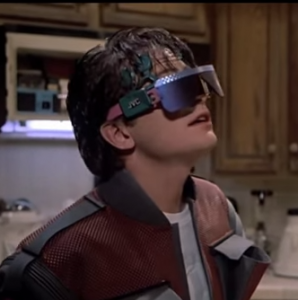 I distinctly remember the first time I saw this scene, and the feeling of wonderment I got at seeing the glasses being worn. I mean, it was a computer that you WEAR. How cool and sci-fi was that?
I distinctly remember the first time I saw this scene, and the feeling of wonderment I got at seeing the glasses being worn. I mean, it was a computer that you WEAR. How cool and sci-fi was that?
(Insert obligatory Google Glass joke here)
Now of course the idea of wearable technology is mainstream. Even if something like Google Glass – the closest real-world example of the technology envisioned in the film – didn’t take off as a consumer product, the reality is that wearable technology is here to stay, as are the potential implications wearables have for learning and performance support.
Performance Support
Technology embedded into workflows enables us to support our work in exciting new ways. There’s a scene in the film where the future McFlys are eating dinner together. Most of the technology focus is on the “hydrator” which takes a small disc and hydrates it into a full-sized cooked pizza in seconds.
I’m still waiting for that tech.
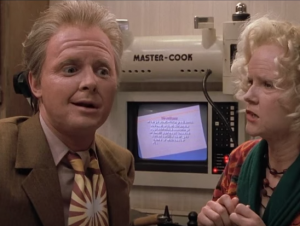 When I was a kid in the 80s, performance support for cooking involved pulling an index card from a file and following a written recipe. Cut ahead to present day, and performance support while cooking takes the form of an iPad, positioned next to me with the recipe, or a YouTube video, or some other sort of coaching – just like the screen on the Master-Cook from the film.
When I was a kid in the 80s, performance support for cooking involved pulling an index card from a file and following a written recipe. Cut ahead to present day, and performance support while cooking takes the form of an iPad, positioned next to me with the recipe, or a YouTube video, or some other sort of coaching – just like the screen on the Master-Cook from the film.
Using Voice Commands
Throughout the future-based scenes of the film, the use of voice commands to interact with technology is common. While this idea was pure science fiction in 1989, it’s commonplace in 2015. It’s in our cars, on our phones, and in the case of something like Amazon’s Echo, increasingly just part of the environment.
The Internet of Things
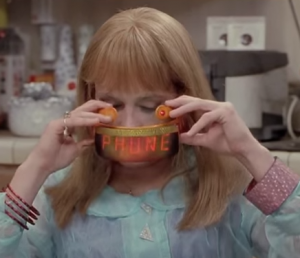 The internet itself isn’t discussed in Back to the Future, but you can see it’s influence throughout the future-based scenes. You can also see aspects of what we now refer to as the Internet of Things, from the home recognizing the owner’s fingerprint, voice, and physical presence and adapting accordingly, to the intergrated garden, to the “phone” call notification received via wearable technology. The film’s home is an environment where everything is connected, and we’re seeing more and more of that today.
The internet itself isn’t discussed in Back to the Future, but you can see it’s influence throughout the future-based scenes. You can also see aspects of what we now refer to as the Internet of Things, from the home recognizing the owner’s fingerprint, voice, and physical presence and adapting accordingly, to the intergrated garden, to the “phone” call notification received via wearable technology. The film’s home is an environment where everything is connected, and we’re seeing more and more of that today.
And of course, a world that recognizes your presence, understands your needs, and supports those needs accordingly is something that has huge potential to disrupt how we look at learning.
Where Did It Miss the Mark?
The Fax Machine
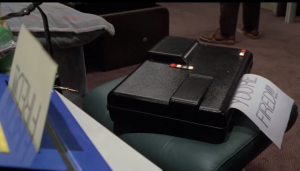 Believe it or not, there was a time when fax machines were cutting edge tech. Apparently the makers of Back to the Future saw faxes as a game-changing technology that would be at the core of future communications, a functionality that is just embedded into different parts of the home. When Marty McFly is fired in the film, multiple devices around the house start spitting out papers with the “You’re Fired” message. It’s the fax-dominated home of the future.
Believe it or not, there was a time when fax machines were cutting edge tech. Apparently the makers of Back to the Future saw faxes as a game-changing technology that would be at the core of future communications, a functionality that is just embedded into different parts of the home. When Marty McFly is fired in the film, multiple devices around the house start spitting out papers with the “You’re Fired” message. It’s the fax-dominated home of the future.
Thankfully… no.
Mobile Phones
The smartphone is one of the most disruptive technologies of the last decade, and something that is fully embedded into the ways many of us live today. We walk around with a device connected to an infinite amount of information, combined with computing power that dwarfs what was available from high-end desktop machine of the 80s and 90s. The smart phone has also completely transformed many of our personal and organizational approaches to learning.
And it’s completely missing as a concept in the film. The idea of a mobile phone was so outside the scope of future possibility to the filmmakers that the movie even includes a reference to a related device that has all but disappeared from the technology landscape of 2015: A pay phone.
Social Media
Social media has redefined how we connect and share with each other. It has practically removed the barriers of time and space from the equation. And it has opened doors to a world of learning that have transformed what we see as possible when it comes to learning from and with each other.
And it’s completely absent from the film as a concept.
The Clothes
Sometimes my words can not accurately depict the horror of a visual. Seriously… what is this about?
Newspapers
How will the people of the future stay informed on the current events? Where will they go to stay informed on the latest news from around the world?
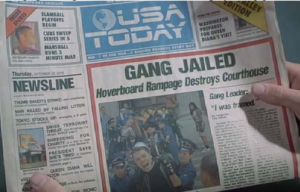 According to the 1980s’ filmmakers vision, in 2015 people will get there news from… newspapers. Sure, newspapers still exist, but they’re rapidly dying out as more content is consumed through digital devices.
According to the 1980s’ filmmakers vision, in 2015 people will get there news from… newspapers. Sure, newspapers still exist, but they’re rapidly dying out as more content is consumed through digital devices.
Ignoring the filmmakers’ use of newspapers as part of the “changing the future” narrative for a moment, the decision to use newspapers as the default method of news consumption is interesting. In hindsight, it’s representative of the resistance to change many publishing companies have battled in the last few decades as digital technologies have disrupted the status quo.
In many ways our approaches to personal and organizational learning are encountering the same external forces of environmental change due to technological innovation. Are you still firmly holding on to and protecting “newspaper”-like approaches to learning, or are you embracing the possibilities of new technologies, even if it means disrupting the comfort of what is?
Predicting the Future of Learning
Predicting the future in the context of a movie like Back to the Future is about fun. In the case of organizational learning, predicting the future of technology is a critical business need. It’s what shapes our strategy, and the decisions on where to invest capital. Trying to predict the future helps us invest our resources more effectively, and avoid investing in what ultimately winds up being a passing fad.
It’s one of the main reasons I am so connected with the eLearning Guild Community, and why I enjoy attending our conferences and other events. The community shares what’s going on in the world of learning and technology, which enables me to keep my finger on that pulse. I also get to explore shared examples of today’s technology in practice, which is critical when it comes to future purchasing and strategy decisions. That’s what has always attracted me to eLearning Guild events, and what makes me return to Guild events year after year. Returning to a Guild event each year helps me plan what I’m going to do next in my work. It is in many ways – if you’ll pardon the pun – my annual opportunity to go “back to the future”.
Oh and one more thing… If it’s 2015, WHERE’S MY FLYING CAR?!?!?

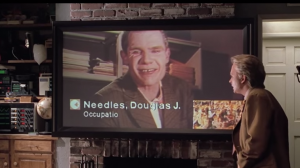
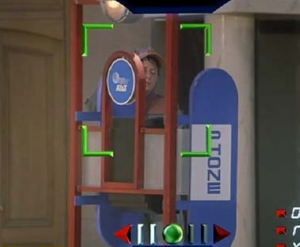
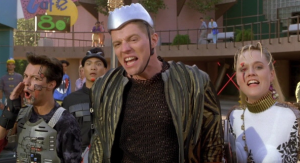
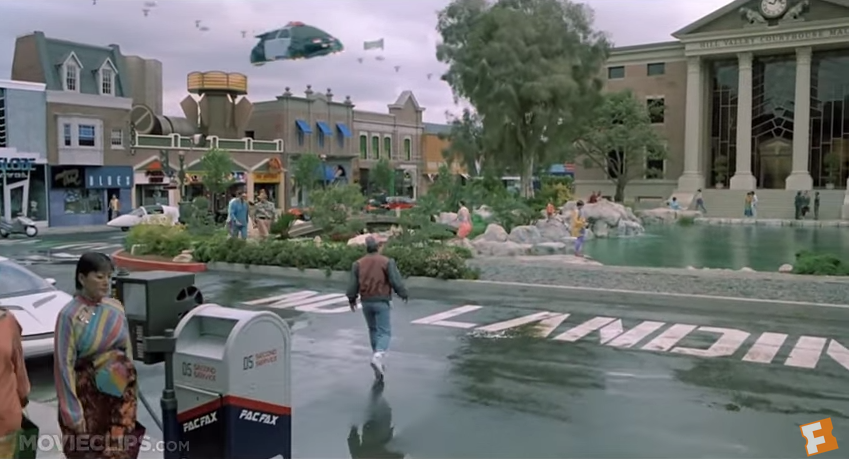
Leave a Reply